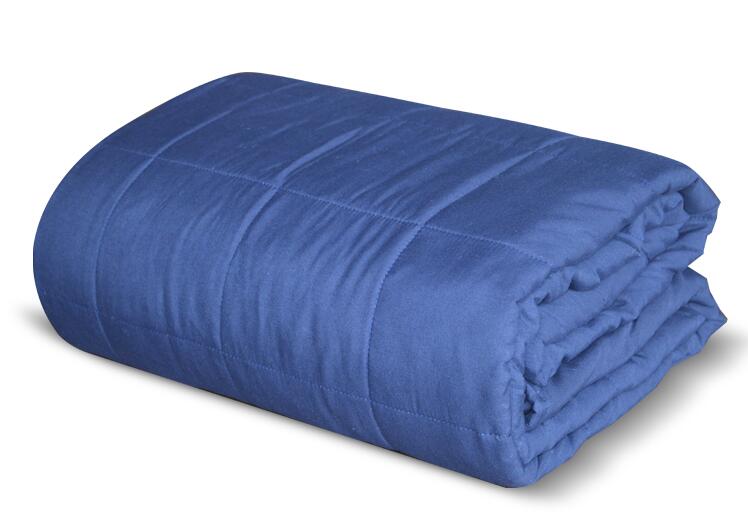How to Choose a Suitable Weighted Blanket: A Comprehensive Guide
2024-10-10
How to Choose a Suitable Weighted Blanket: A Comprehensive Guide
Weighted blankets have gained significant popularity in recent years, especially for their ability to provide comfort, improve sleep quality, and alleviate stress. Whether you’re looking to ease anxiety, enhance relaxation, or simply sleep better, choosing the right weighted blanket is crucial. However, with so many options available, it can be overwhelming to determine which one is the best fit for your needs. This guide will explore the various factors you need to consider, from weight and size to material and care, to help you make an informed decision.
1. Determine the Ideal Weight of the Blanket
Choosing the correct weight for your blanket is the first and most important factor. The right weight can enhance the therapeutic benefits of a weighted blanket, while an unsuitable weight can lead to discomfort or even negative health impacts.
The General Rule: 10% of Your Body Weight
Most experts recommend choosing a weighted blanket that is approximately 10% of your body weight. This rule provides a rough guideline for selecting the appropriate level of pressure and comfort. For instance, if you weigh around 150 pounds, you would typically look for a 15-pound blanket. This weight creates a gentle, even pressure that simulates the sensation of being hugged, which can help calm the nervous system and improve sleep.
However, while this is a good starting point, preferences can vary. Some people may prefer a slightly lighter or heavier blanket depending on how they react to pressure and their specific comfort needs.
Children and Elderly Considerations
If you are buying a weighted blanket for a child, elderly person, or someone with health concerns, you should opt for a lighter blanket. For children, the blanket should be around 5-7% of their body weight. For the elderly, a blanket that is too heavy may cause physical strain or limit movement, so it’s best to err on the side of caution and choose a lighter option.
2. Choosing the Right Size
Once you’ve decided on the appropriate weight, the next consideration is size. Weighted blankets come in various sizes, designed for different bed dimensions and personal preferences.
Match the Size to Your Bed
One common mistake people make is choosing a blanket that is too large for their bed. While it may seem like bigger is better, a large weighted blanket can easily slide off the bed during the night, disrupting your sleep. Therefore, it’s important to select a size that fits your mattress but doesn’t have too much overhang.
For example, if you have a queen-sized bed, choose a blanket that’s also designed for a queen size. Keep in mind that you don’t necessarily need a blanket that covers the entire bed—especially if you’re sleeping alone. A smaller blanket that focuses on your body may be more comfortable and practical.
Personal Blanket Size
If you share a bed, you may want to get a smaller, individual-sized blanket rather than one that covers the whole bed. Sharing a weighted blanket can be tricky, especially if your partner doesn’t enjoy the same weight or level of pressure. Personal-sized blankets allow each person to customize their comfort.
3. Selecting the Right Material
Material plays a huge role in the comfort and functionality of your weighted blanket. There are two key material aspects to consider: the outer cover and the inner filling.
Outer Cover Material
The fabric of the blanket’s cover will determine how it feels against your skin, and it’s important to choose a material that suits your preferences and the climate you live in. Common materials include:
Cotton: Cotton is one of the most popular materials for weighted blankets. It’s breathable, soft, and suitable for year-round use. If you tend to get hot while sleeping, cotton is a great choice as it allows airflow.
Bamboo: Bamboo fabric is known for its cooling properties and moisture-wicking capabilities. If you’re a hot sleeper or live in a warm climate, bamboo can help regulate your temperature and keep you comfortable throughout the night.
Fleece or Minky: These plush, cozy fabrics are perfect for cold weather or anyone who enjoys a warm and cuddly feel. They trap heat well, so they might not be ideal if you tend to overheat during the night.
Linen: Linen is another breathable, natural option that works well in warmer climates. It has a textured feel and is highly durable.
Inner Filling Material
The filling inside the weighted blanket is what gives it its weight. There are two main types of filling materials:
Glass Beads: Glass beads are the most common and preferred filling for weighted blankets. They are small, smooth, and almost silent, making the blanket feel soft and luxurious. Glass beads distribute weight evenly and don’t make noise when the blanket is moved, which can contribute to a more restful sleep.
Plastic Pellets: Plastic pellets are another option, often used in more affordable weighted blankets. While they provide similar weight, they tend to be bulkier and noisier than glass beads, which may disrupt sleep for light sleepers.
It’s also important to check the stitching of the blanket to ensure that the filling is evenly distributed across the entire surface. Uneven filling can create uncomfortable lumps and prevent the blanket from providing consistent pressure.
4. Breathability: Stay Cool or Stay Warm
Temperature regulation is a key consideration when choosing a weighted blanket. Some blankets are designed to be warm and cozy, while others are made with cooling materials for hot sleepers.
For Hot Sleepers
If you tend to get hot at night, look for a blanket made from breathable, moisture-wicking fabrics such as cotton or bamboo. Some weighted blankets are specifically designed with cooling technology, such as gel-infused beads or fabrics that promote airflow. Choosing a lighter-weight blanket can also help prevent overheating.
For Cold Sleepers
If you prefer warmth, opt for a blanket made from materials like fleece or minky. These fabrics provide excellent insulation and can make your bed feel cozy and inviting. However, if you live in a temperate climate, you may want to invest in a blanket with a removable, reversible cover—one side for cooling and one for warmth.
5. Care and Maintenance
Weighted blankets are an investment, and proper care can extend their lifespan. Before purchasing, check the manufacturer’s care instructions to ensure that the blanket fits your lifestyle.
Washability
Some weighted blankets come with a removable, machine-washable cover, making them easier to clean. This is especially important if you plan to use the blanket frequently or if it will be exposed to pets or children. Blankets without removable covers can be more challenging to wash, as the weight makes them difficult to handle in a standard washing machine.
Durability
Check the stitching to ensure the blanket is well-constructed and the filling won’t shift or leak over time. High-quality blankets will have strong, reinforced stitching and securely sewn pockets to keep the weight evenly distributed.
6. Price and Budget
Weighted blankets can range in price from $50 to $300 or more, depending on factors such as size, weight, material, and brand. While it may be tempting to go for a cheaper option, investing in a higher-quality blanket often pays off in terms of comfort and durability.
Budget Considerations
Set a budget that balances affordability with quality. If you’re buying a weighted blanket for therapeutic reasons, it’s worth investing in a more durable, premium option. Many brands also offer financing options, which can make the purchase more manageable.
7. Trial Period and Warranty
Finally, check whether the blanket comes with a trial period or warranty. Some brands offer a satisfaction guarantee, allowing you to return or exchange the blanket if it doesn’t meet your expectations. This can provide peace of mind, especially if you’re unsure about how a weighted blanket will feel or if it will improve your sleep quality.
In conclusion, choosing a suitable weighted blanket involves understanding your personal needs and preferences, as well as the technical specifications of the blanket itself. By considering factors such as weight, size, material, breathability, and care, you can select a blanket that enhances your comfort, supports better sleep, and provides long-lasting value.



